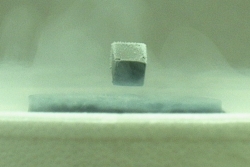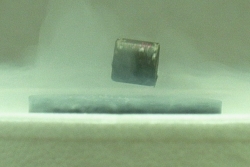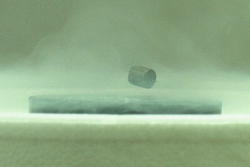 |
 |
 |
 |
 |
 |
Above are three photographs of different magnets floating above a superconductive disc. The disc is a “BSCCO” disc, that is, bismuth strontium calcium copper oxide. The general formula for this compound is Bi2Sr2CanCun+1O2n+x. Ours is Bi2Sr2Ca2Cu3O10. We also have “YBCO,” which is yttrium barium copper oxide in the proportions YBa2Cu3O7.
These materials are called high-temperature superconductors, because their critical temperature, the temperature below which they become superconductive, is at or above liquid nitrogen temperature (77 K). For BSCCO, the critical temperature is about 108 K, and for YBCO, it is about 93 K. You can find a brief explanation of superconductivity on the page for demonstration 64.27 -- Measure voltage drop in superconductor.
In 1933, Walther Meissner and Robert Ochsenfeld discovered that when materials were cooled below their critical temperatures and became superconductors, they excluded magnetic flux; the materials became diamagnetic. (See demonstration 68.69 -- Magnetic materials.) They found that this happened both when the substances were cooled to below their critical temperatures in the presence of a magnetic field, and when the magnetic field was applied after they were cooled. This phenomenon (or pair of phenomena) is known as the Meissner effect, and is sometimes called the Meissner-Ochsenfeld effect.
The diamagnetism of a superconductor arises in a similar way to that of a diamagnetic atom, and both are a consequence of Lenz’s law (see demonstration 72.09 -- Lenz’s law), which states that the current generated by a changing magnetic flux flows in such a direction as to oppose the change in flux that produced it. In a diamagnetic atom, the outer electrons adjust their motion to produce a net magnetic moment that opposes the applied field. Similarly in a superconductor, the conduction electrons move in such a way as to produce a magnetic moment that opposes the applied field. They cannot do so, however, against the electrical resistance that normally obtains above the critical temperature of the superconductor. Once this resistance is removed when the superconductor is cooled below its critical temperature, the conduction electrons are free to move about, and the persisting current they set up, in generating an opposing magnetic field, excludes the flux from an applied magnetic field.
If you apply a magnetic field that is strong enough, that is, above what is known as the critical field, the superconductor ceases to be superconductive and reverts to its normal state. The magnitude of this field for a given material depends on the temperature, and it goes from zero at the nominal critical temperature, to some value at 0 K, above which the material cannot be superconductive at any temperature. The reason for this is that when a superconductor excludes a magnetic field, there is an associated decrease of energy in the field, which is balanced by an increase in the energy of the electrons in the persisting current. As you increase the strength of the magnetic field, the energy of the electrons increases until the energy of the superconducting state of the material becomes higher than the energy of its normal state, and the material relaxes to its normal state and ceases to be superconductive.
References:
1) Eisberg, Robert and Resnick, Robert. Quantum Physics of Atoms, Molecules, Solids, Nuclei and Particles (New York: John Wiley and Sons, Inc., 1974), pp. 525-527.
2) https://nationalmaglab.org/education/magnet-academy/history-of-electricity-magnetism/pioneers/walther-meissner.